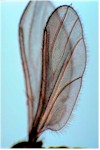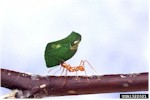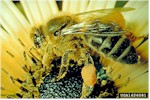|
|
Insect Respect |
Now who do you suppose tidies up our Earth and recycles all
the debris left by animals and the natural processes that occur in the environment?
That's right, those industrious hard-working little insects. Insects are absolutely
necessary in the processes of the balance of nature. Besides cleaning up and
recycling, they: are the major pollinators of fruits and flowers, provide food for
other animals (they are the food!), provide products (honey, silk, etc.), eat other
harmful insects, some act in partnership with other plants and organisms, and they keep
the soil loose so that the roots of plants can grow. All these benefits from such tiny
creatures.
So, watch your step! They deserve our respect and appreciation, don't you agree?
|
|
Insectclopedia |
Insectclopedia
An
encyclopedia of insects and related fields. Species links, searchable
database, bug I.D., definitions, online resources, hobbies, insect
control, medical links, and bugfood.
Note: Edible insects contain superior nutritional content, but not all insects are edible.
Some insects are toxic!!
|
|
Insects on WWW |
Huge list of links related to entomology.
|
|
Insecta |
Insecta
The
Spencer Entomological Museum (University of British Columbia) has about
600,000 insect specimens in its collections. Take a tour of the
museum (click on The museum is...) and you can see how the specimens are
carefully labeled and preserved in wooden cases with tight fitting glass
lids. Some specimens are preserved in alcohol. Why are museum
collections important?
Insect Lore contains the Family tree of the class Insecta, and a glossary.
Bugs of the Month provides scientific information and photographs of some
of the museum insect guests (all the insects have been bugging the
curator to take their pictures!)
Future additions to this website will be: Careers in Entomology, The Insect Popularity Contest, Heads Bodies and Legs,
and Medical Entomology: The Bugs on You. (We're just itching
to learn more, aren't you?)
|
|
Bugs |
Bugs: the Good, the
Bad, and the Ugly
Pollinators, pests, and the
not-so-pretty.
(U.S. Dept of Agriculture, Beltsville Area, Maryland) |
Smithsonian
|
Entomology
- Department of Systematic Biology
Smithsonian's
BugInfo provides interesting facts,
information sheets and links to resources pertaining to insects.
(Encyclopedia Smithsonian)
|
|
Insecta Inspecta |
The building of Insecta Inspecta World was the culmination of a year long
research activity of the Thornton Jr. High School Honors Academy, conducted
under the review of the National Museum of Natural History, Smithsonian
Institution. Learn a bit more about ants, bees, beetles, butterflies,
crickets, fleas, mantids, mosquitoes, termites, true bugs, and
interesting facts about bugs.
|
|
Entomology
Index |
Iowa State University's directory and search engine of insect-related
resources on the Internet provides a wealth of resources, including:
Bibliographies, Checklists, Collections, Companies, Databases, Directories,
Image Galleries, Institutions, Integrated Pest Management, Keys, K-12
Resources, Lesson Plans, Online Courses, Pesticides, Sounds of Insects and
much more.
|
|
Bug Bios |
Bug Bios looks into the past to
discover the importance of insects in human culture and Earth's biodiversity.
Click on entophiles and then the various
groupings. Photographs are from Ecuador, Brazil, California, and Hawaii (click on
picture to bring up description, and then click on photographic enlargement for a detailed
"bug's eye view").
Click on Entolinks for a list of reviewed insect-related Web sites which
will provide thousands of links to entomological information.
"With few visible flowering plants in tropical rainforests, insects have been
named the flowers of the jungle."
|
|
Metamorphosis |
Metamorphosis Bug
Show - The cycle of changes some insects go through as they develop from
birth to adult stage. (Graphic illustrations, EPA Masterbug Theatre)
|
Lepidopterans
-
Caterpillars
Butterflies
Moths
Skippers |
Lepidopterans
- Encyclopedia Brittanica
Caterpillars of Pacific Northwest Forests and Woodlands -
scroll down to Table of Contents.
Caterpillars
of Eastern Forests - scroll down to Table of
Contents.
Butterflies
of North America
Moths
of North America
Web
Images of North American Moth Species
Rearing
Butterflies and Moths
- read
recommendations and warnings of The Unexpected - you may be surprised by
what emerges from the chrysalis or cocoon you have nurtured.
Note: Do not collect specimens on public lands without first determining if permission or collecting permits are
required.
Also see our Mega Resource
Directories page for Lepidoptera and Entomology/Biology lists of worldwide
website links.
|
What's this
Caterpillar? |
" What's this caterpillar?
"
has information to help you identify caterpillars in Britain and Europe.
Over 800 species listed. Look for the picture of the camera to find
pictures of species. Link provided to their partner site:
" What's
this North American Caterpillar? "
|
|
Myrmecology |
Myrmecology
is the
scientific study of ants. This site contains a searchable database,
links to ants in specific locations around the world, ant facts, images, an
introduction to Myrmecology, and other helpful links, activities and
information.
|
 |
Dragonfly
 |
Ant
 |
Leaf cutting ant

Credit: insectimages.org |
Honeybee covered
with pollen

Credit: insectimages.org |
|